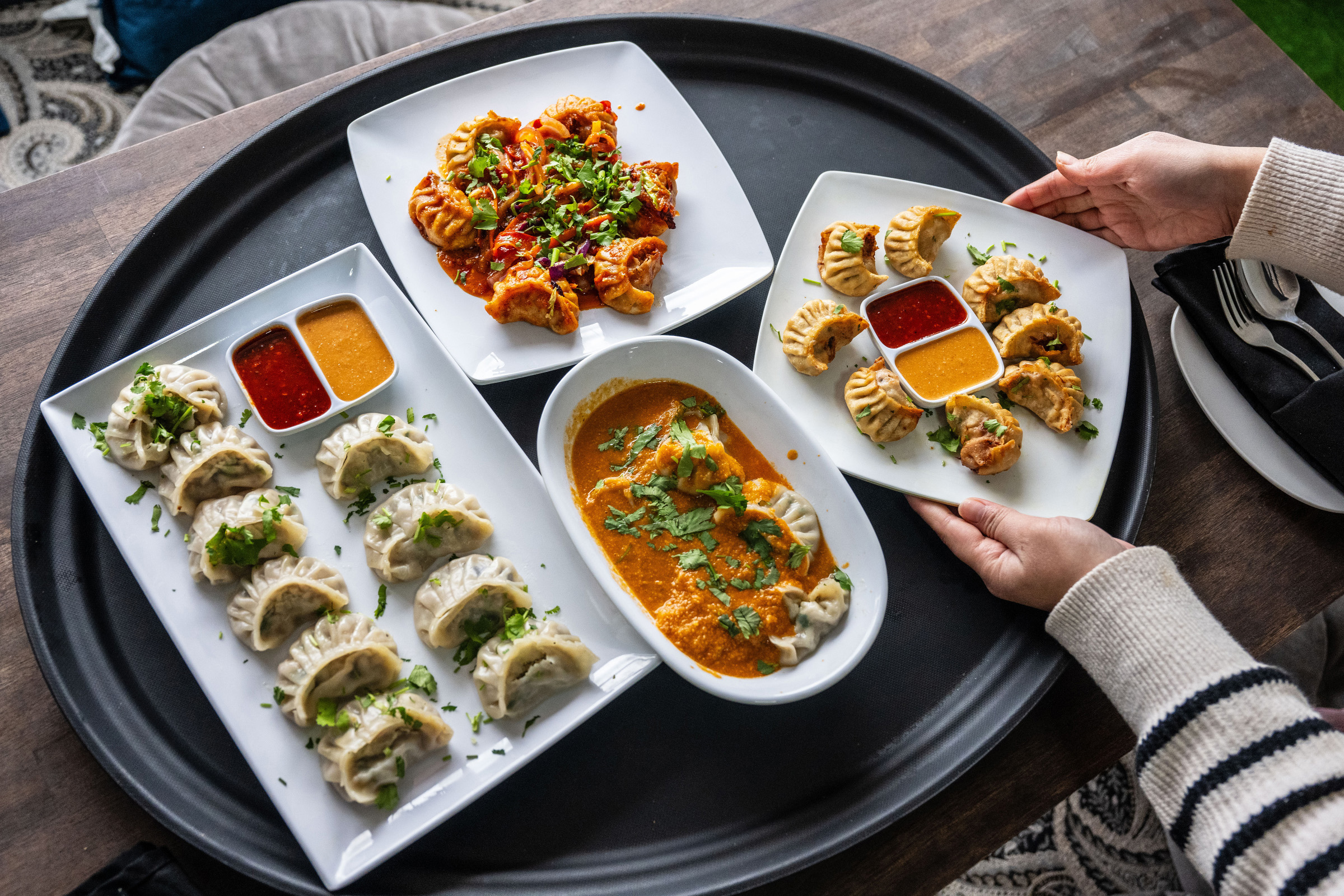
LOADING


A bouquet of garlic, ginger, star anise and chili peppers whispers through the Allegheny Spice Kitchen dining room as Pawan Ghimirey delivers a steaming pressure cooker from the Baldwin restaurant’s kitchen.
The oblong steel-gray pot hisses as the release valve yields, revealing a bubbling cauldron of plump dumplings inhaling a volcanic brick-red broth. Hunks of tender goat meat bob alongside them.
Ghimirey’s pressure-cooked momo are an of-the-moment take on the signature dumpling of the Himalayas.
The mighty momo offers Allegheny County’s substantial population of Bhutanese refugees — who transitioned to American life in the late 2000s after years in Nepalese camps — a chance to share their multifaceted food culture.
Fifteen years into their regional resettlement, they are widening their culinary reach from a handful of restaurants that opened in the South Hills in the mid-2010s as new generations of restaurateurs distinguish themselves in an increasingly dynamic market.
Momo are their gateway to making it happen.
“I’m trying to help my community by showing our food at this restaurant,” says Ghimirey, owner of Allegheny Spice Kitchen on Route 51. “I want to make it something very special for Pittsburgh. I try to be creative and give people tastes that they will love.
“I live in Allegheny County and I love this place. That’s why I chose the name for the restaurant.”
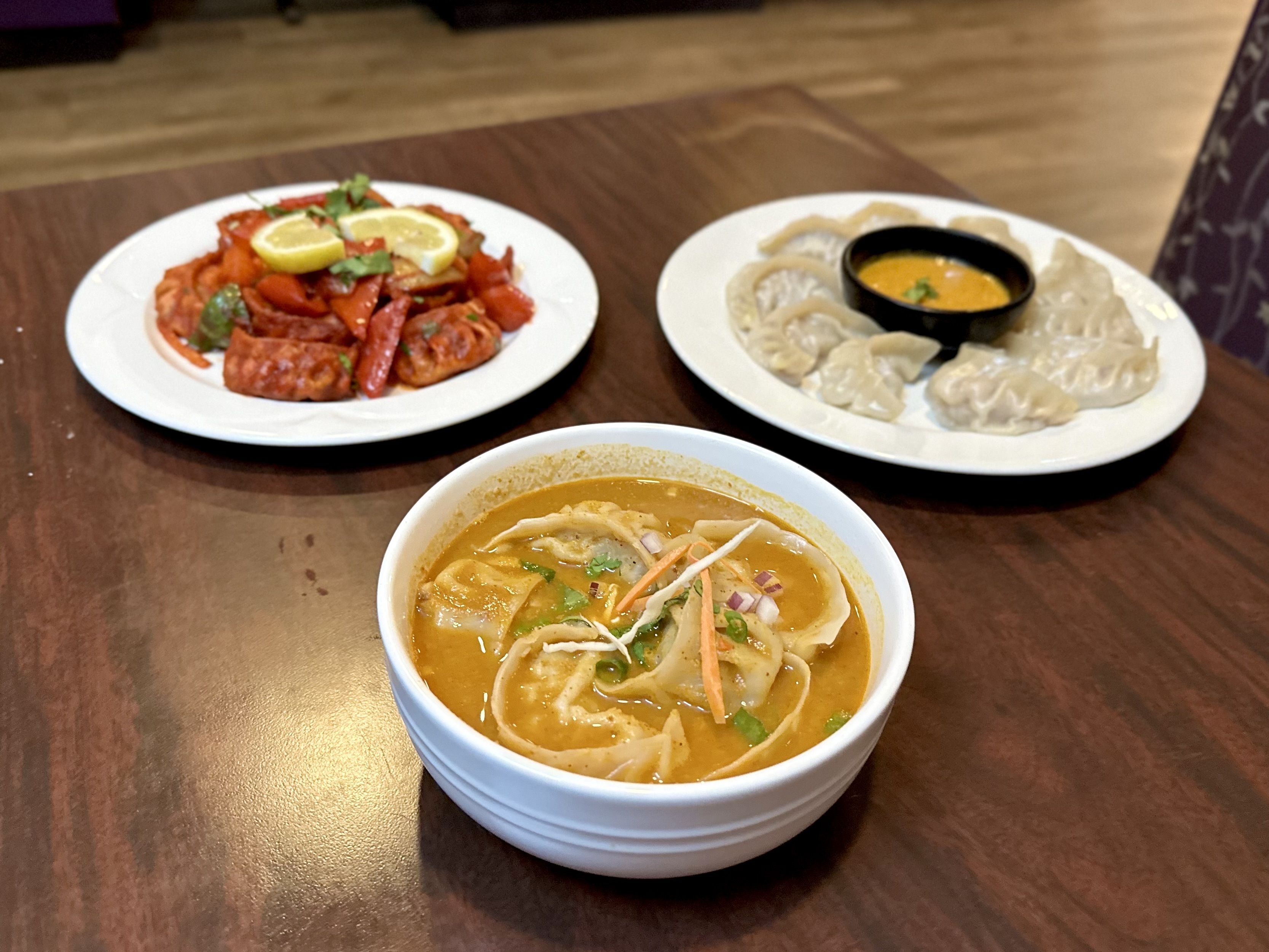
Momo boasts deep roots in the high mountains of the Himalayas, with limited records suggesting their introduction in Tibet around the 14th century. They feature thicker wrappers than their Chinese jiaozi cousins and were likely first filled with yak meat, suiting the nomadic lifestyle of the area.
As momo spread to Nepal and trade routes with India expanded, a host of spices, including cumin and coriander, were incorporated into fillings. This is also the first time in our geographic exploration of Pittsburgh’s dumplings that we find cheese (typically a simple farmer’s cheese) used as a component.
Restaurants serving our favorite Himalayan dumplingsHow to make Bhutanese dumplings at home
While the dumplings at Western Pennsylvania’s 11 Bhutanese-Nepali restaurants speak a similar primary language, their chefs find jazz within the framework.
“Momo is one of the healthiest dishes you can have. It's cooked by steam and it's the most tasty dumpling,” says Kamal Timsina, owner of Double Fresh, a small restaurant in a Baldwin Borough grocery store. “I want everyone in Pittsburgh to be able to taste them and examine the difference in our cuisine.”
Don't let the seemingly straightforward simplicity of steamed momo fool you. Each restaurant’s fillings are a dynamic expression of culinary identity. Chicken and vegetables, not generally considered big hitters in the dumpling world, are almost always the standouts, though you’ll also find excellent pork and mutton (goat) stuffings.
At D’s Bubble Tea & Cafe in Carrick, the chicken steamed momo is subtle, with gingery and herbaceous flavors at the forefront. Taste of the Himalayas’ filling is bolder — and juicy, with strong notes of onion and cilantro. Double Fresh serves refreshing veggie momo with a balance of crisp cabbage and soothing farmers’ cheese.
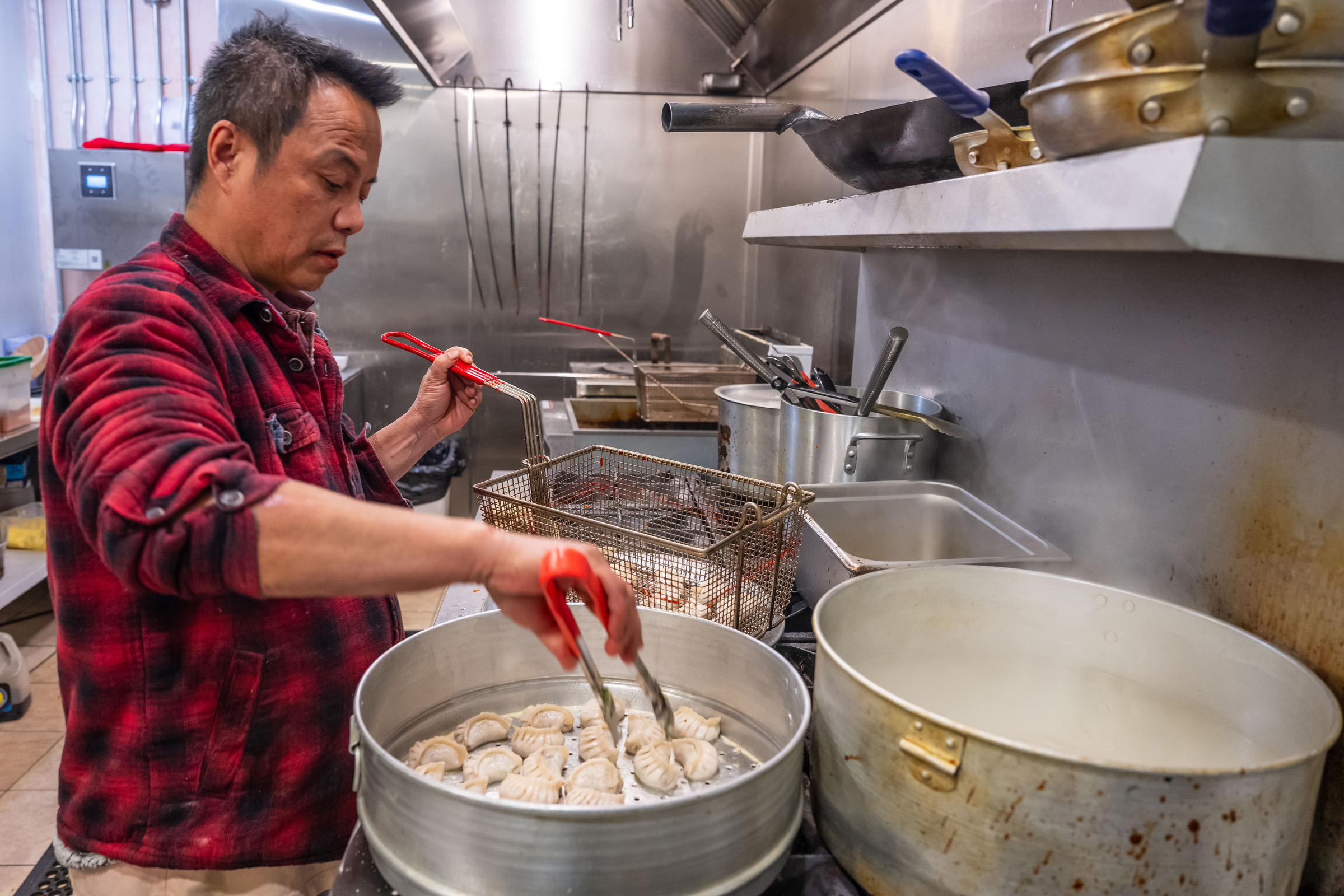
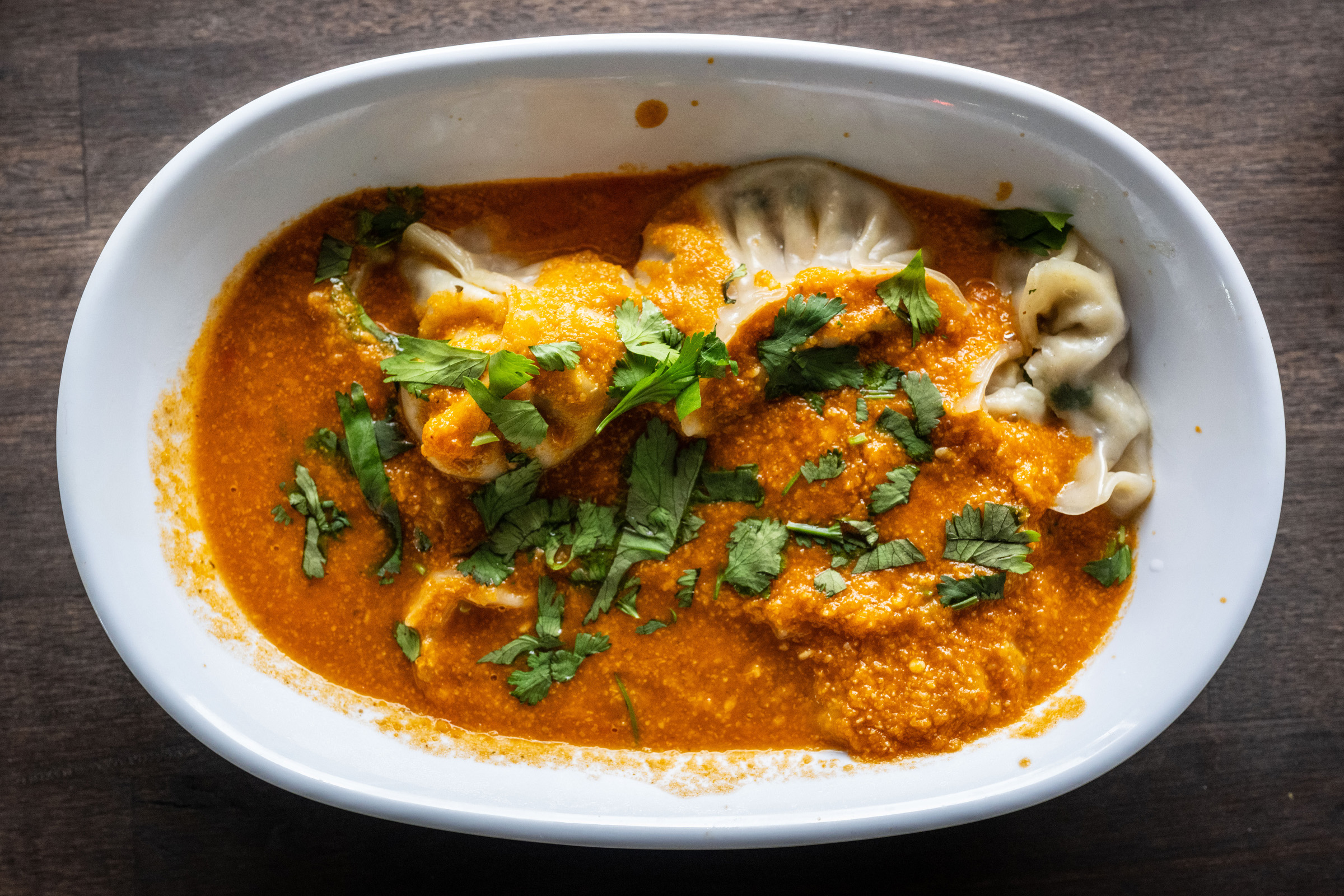
The accompanying sauce earns its place in the spotlight more than any we've encountered so far on Pittsburgh’s dumpling trail.
“We like to focus as much as we can on the dipping sauce. Simple stuffing lets the sauces shine,” says Arati Thapa, co-owner of D’s. She and her husband, Dinesh Nepal, use her mother’s recipes as the building blocks for the momo they offer at their just-opened restaurant.
All the Bhutanese establishments in Pittsburgh serve house-made momo chutney, sometimes known as achar.
“Every hand mixes differently, so every restaurant will have a sauce that represents them,” says Timsina, who was 10 when his family was expelled from Bhutan in 1992. He arrived in the United States in 2009.

Double Fresh’s chili- and cumin-forward chutney doesn’t pull punches as it mingles with the lush vegetable filling. D’s offering tilts the other way; ground sesame seed is the base for a soft, creamy achar budding with a lighter heat.
There's room to play elsewhere, too.
Jhol momo invites the dumpling into the achar by turning the chutney base into a broth. The degree of soupiness varies with the destination.
Namaste Momo Corner, one of the pioneers of the South Hills Bhutanese restaurants when it opened in 2018, serves J-momo with medium-thin wrappers that take on an almost elastic quality as they swim in a spicy tomato-forward broth.

At Taste of the Himalayas, the skins become extra supple, sucking in an earthy baking spice flavor and gentle heat that infuses the filling. It wraps around the tongue like a late-arc wing on the YouTube series “Hot Ones,” when the spice hits in a sneak attack minutes after eating.
Chili momo, often called C-momo, are fried and sauced prior to service. At Carrick Bar & Grill, the C-momo are tender-crisp and bathed in an oily burnt sienna-hued laced with cumin and paprika, delivering a frontal heat that keeps building toward a lingering crescendo. D’s presentation is festive, with a rainbow of bell peppers, cabbage, onions and herbs mingling with a tangy-sweet sauce.
“It all depends on where you come from. There are places that do heavier spices and other people that serve it more plain. That’s how I grew up, so that’s how I like it,” says Thapa.
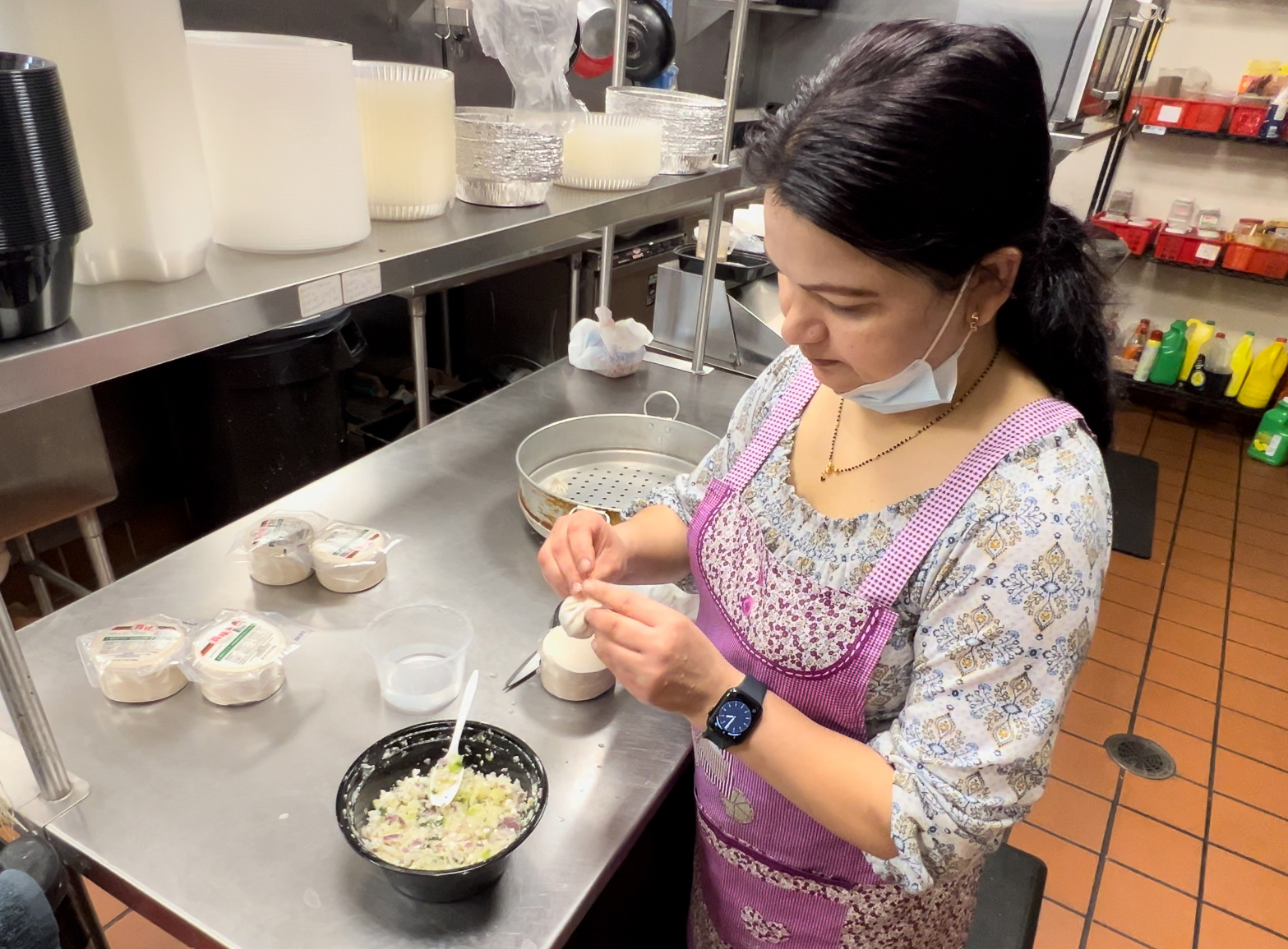
Momo are relatively new to the Bhutanese refugee group, which has experienced a significant need for adaptation over the past half-century.
“In the camp, many of our men and women learned how to make momo. It wasn’t as popular in the villages back in Bhutan. When we came here to Pittsburgh, that continued,” says Khara Timsina, executive director of Bhutanese Community Association of Pittsburgh. “It is now a part of the Bhutanese-American canon of dishes.”
The Bhutanese in Pittsburgh are primarily Lhotshampa, ethnic Nepali who settled in Bhutan in the 1890s. They maintained their culture and Hindu faith for nearly a century until a government crackdown in the late 1980s attempted to force their assimilation into greater Bhutanese culture. The Lhotshampa were expelled, settling into refugee camps in eastern Nepal, where they mingled with local populations, including an embracement of Nepali dishes like momo.
When mediation for the Lhotshampa to return to Bhutan failed, the United Nations began offering resettlement in other countries, including the United States.
Over the years, Pittsburgh, seen as a place for opportunities, has become a prominent settlement. The first Bhutanese refugees came to Pittsburgh in 2008. There were 23 then, a number that grew to 100 by the end of the year.
Timsina estimates that the population in the Pittsburgh metropolitan area now exceeds 7,000, making it the largest refugee cadre in the region.
“There are things that American Bhutanese-Nepali have here that attract people from other locations,” Timsina says, noting opportunity drew him to Pittsburgh from New York City in 2009.
“For example, we have a community organization that has its own office and bilingual employees to help its country members get assistance. This is a source of help that people can’t easily get in many other cities. People also say there are employment opportunities and affordable housing.”
In Pittsburgh, the utter delight of eating momo serves as a bridge between those worlds.

“Initially, we were mostly concentrated in one area, so most businesses opened up surrounding that area. As people started moving to more areas, so did the groceries and restaurants,” Timsina says.
The local community primarily remains based in Whitehall, Baldwin and Carrick, but communities now extend to Rostraver in Westmoreland County and Canonsburg in Washington County.
“It’s not just the Bhutanese-Nepalese who eat there as we build restaurants. They open space for long-term residents to taste food from somewhere else, and that opens conversations and friendship,” says Timsina.
Thapa and Nepal, ages 9 and 10 when they arrived in Pittsburgh and now in their mid-20s, represent a new generation of restaurant operators. The Carlow University graduates opened D’s in March, adding bubble tea and crackling South Indian dosa to a menu filled with Nepali and Bhutanese dishes.
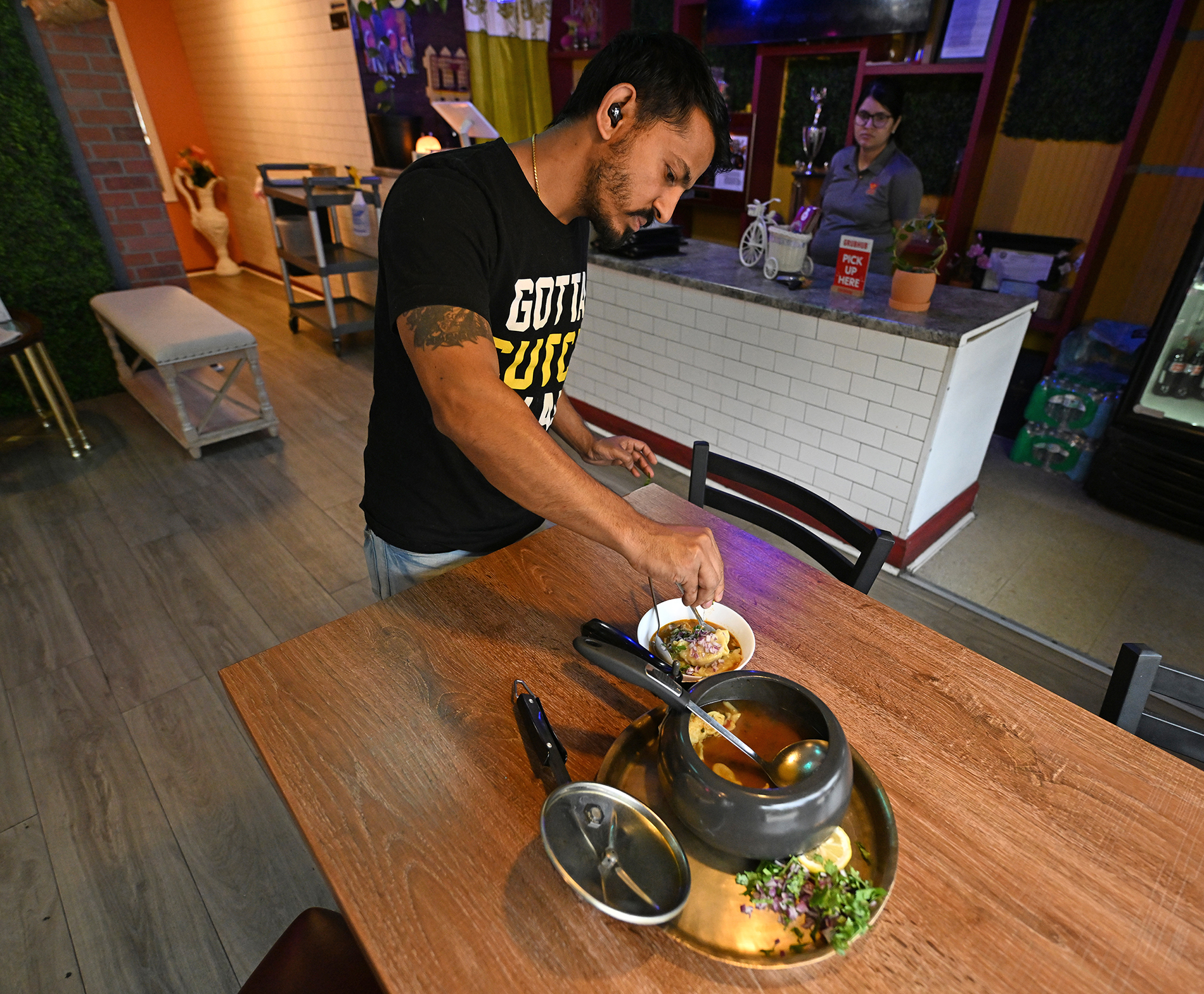
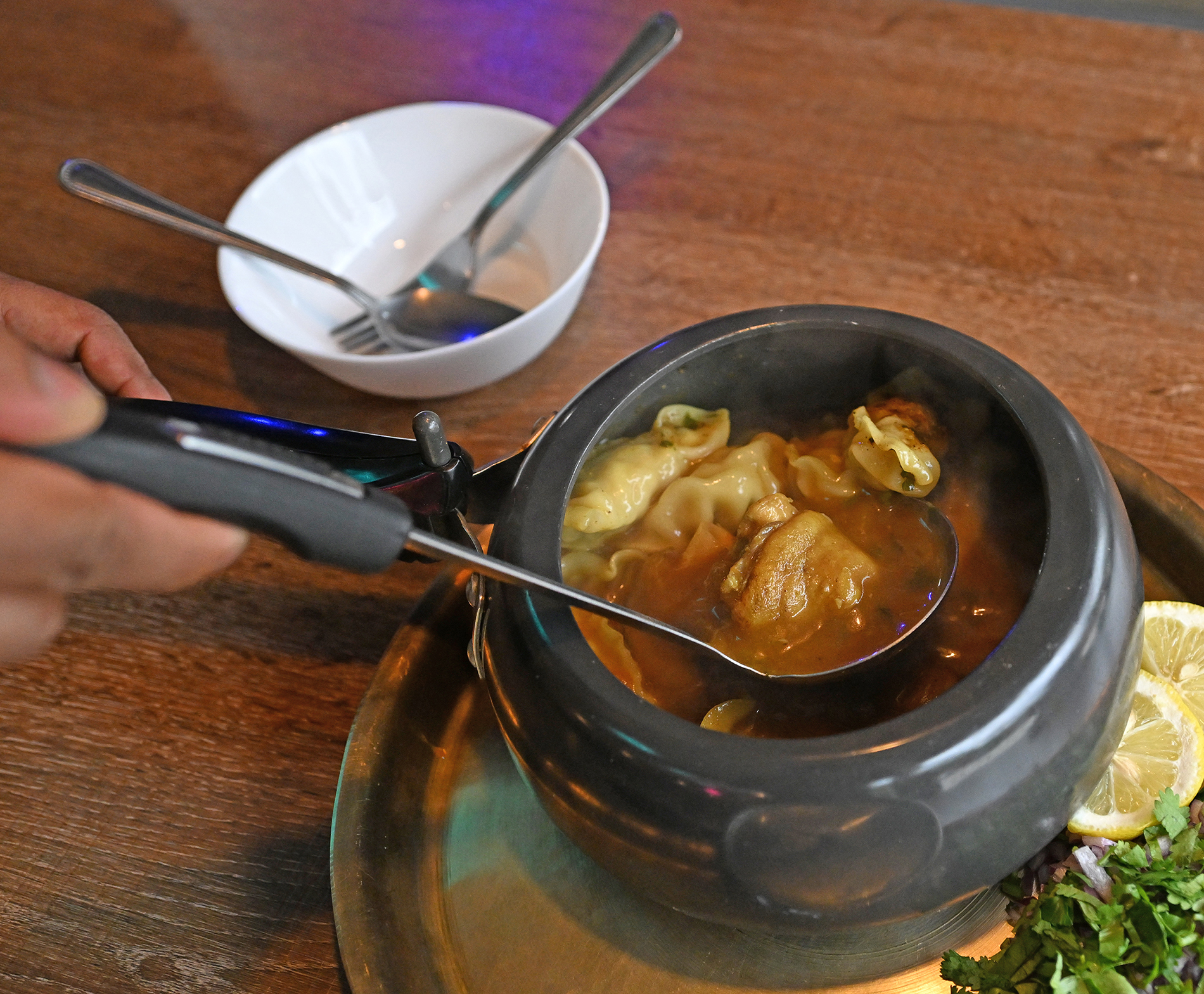
“What’s next? Let’s learn something new that we can become experts in,” Nepal says. “We want people to come to us for a different taste. It makes it easier to compete.”
Ghimery, like many of his fellow restaurateurs, sees his role as integral to this cultural exchange. He moved to Pittsburgh from Texas in 2011, and operated several businesses prior to opening Allegheny Spice Kitchen in February.
He rebranded the space from its former name, Sagun Asian Restaurant, as a symbol of his community’s contributions to Pittsburgh’s ever-growing diverse culinary traditions.
Like his enticing pressure-cooker offering, his momo are part of the way he hopes to weave new patterns into the region’s gastronomic tapestry. He’s already looking ahead to his next introduction: a smoky, tandoor-cooked dumpling.
“We have freedom in this country,” he says. “You can have a good business, you can have a good education. If you work hard and focus on the job you’re doing, you can make it a big success.”
Hal B. Klein: hklein@post-gazette.com
Where to get momo in Pittsburgh
Most of Pittsburgh’s Bhutanese-Nepali restaurants operate in the corridor of Route 51 and Brownsville Road in Carrick, Brentwood and Baldwin, though a few outliers are also worth attention.
The ideal way to explore the momo trail is to gather a small group and visit multiple locations, then order a steamed momo and at least one other version (depending on your group size) at each establishment.

Allegheny Spice Kitchen
Fresh-made and innovative are two driving qualities at Allegheny Spice Kitchen, which opened in February in a space that previously housed a different Bhutanese-Nepali restaurant. As of press time, it’s the only place in town to get pressure cooker momo. Those are worth ordering just for the theater of a small, oblong pressure cooker hissing aromatics as tender dumplings are revealed in a vigorously bubbling, super-savory broth. Sadeko momo — we’re fans of the one with a mild chopped chicken filling — have a lightly fried encasement and comes stacked like tiles. The gorgeous salad on top adds extra crunch and spice.
4871 Clairton Blvd., Baldwin
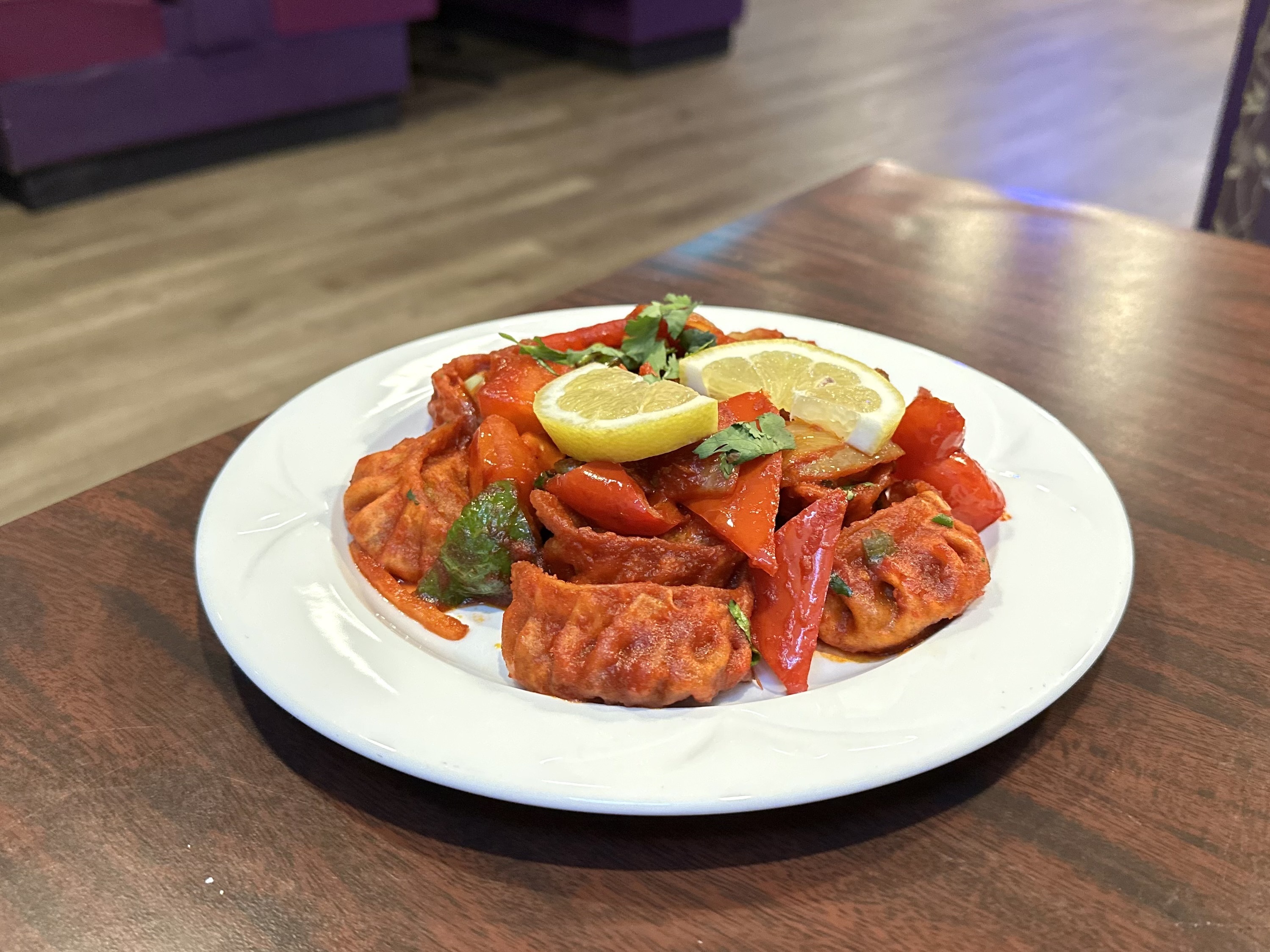
Taste of the Himalayas
The wrappers on Taste of the Himalayas’ J-momo get extra supple as they inhale the earthy baking spice seasoning of the artfully prepared, deceptively hot broth. Be sure to order steamed momo, too; the skins have a pleasant chew that yields a filling with big flavors of onion and cilantro. The achar is light and zesty, with an even more concentrated building heat than the J-momo. Chili momo have a good tug in the lightly fried casings, and a squeeze of lemon gives the sweet-spicy coating a beautiful brightness.
5134 Clairton Blvd., Baldwin; tasteofthehimalayapa.com
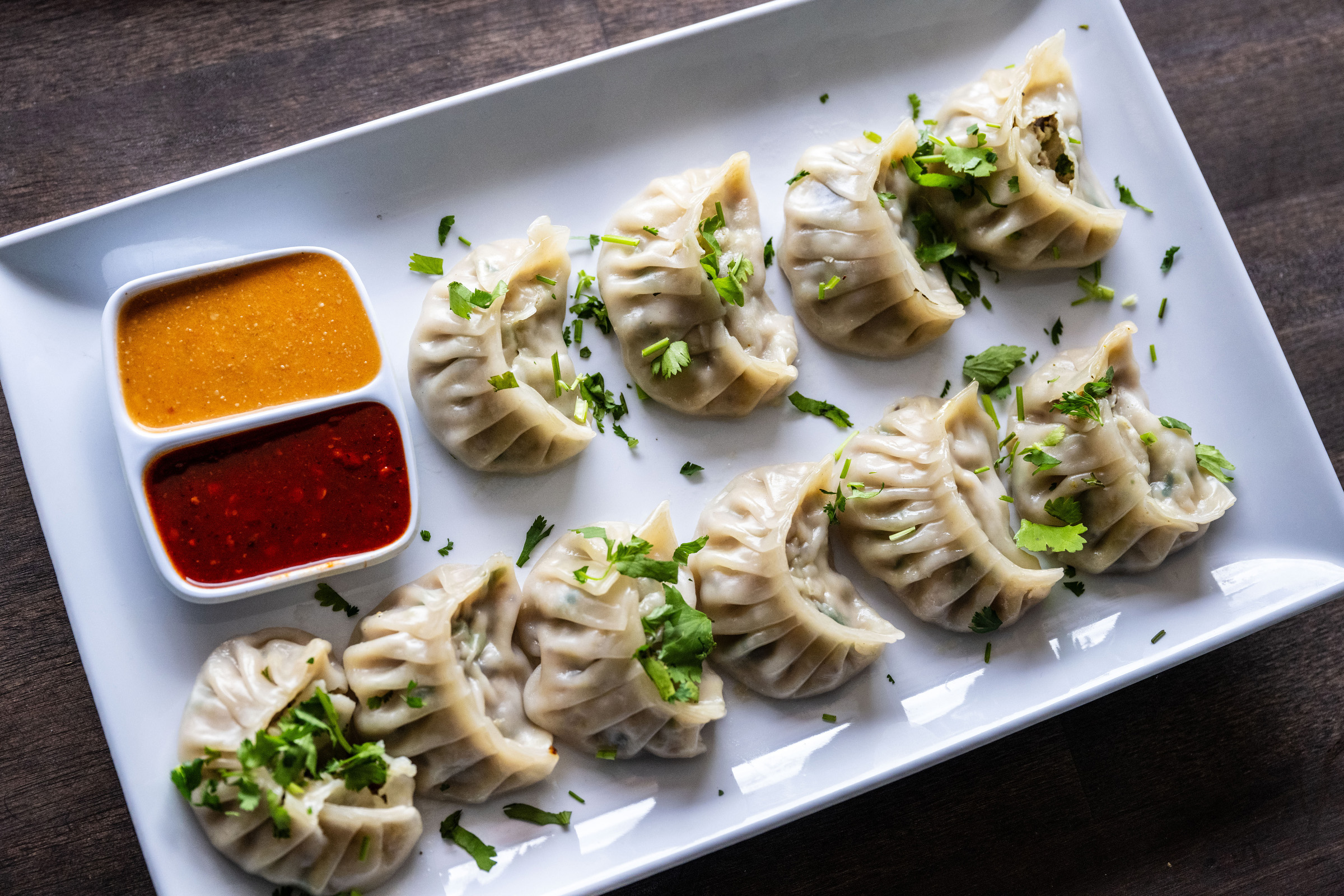
D’s Bubble Tea & Cafe
Start with gingery and herbaceous steamed chicken momo at D’s Bubble Tea & Cafe, which opened in March. The bright bouquet and balanced filling-to-wrapper ratio allow the restaurant’s soft, creamy momo sauce (prepared with a base of sesame seeds) to sing. Lightly fried chili momo are festively presented with a colorful mix of peppers, onions, purple cabbage and cilantro. As you might surmise from the name, D’s offers tasty bubble tea, as well as something you wouldn’t guess: crisp, savory South Indian dosa.
3623 Brownsville Road, Brentwood; dbubbleteandcafe.com
Double Fresh
The small restaurant tucked inside a grocery store with the same name offers some of Pittsburgh’s most refreshing and invigorating momo. The two-person kitchen crew prepares light, fresh vegetable dumplings with vegetal cabbage notes balanced by creamy bites of farmer's cheese. The chicken filling is well seasoned, juicy and packed with more vegetables. The momo chutney at Double Fresh is assertive. Its pull-no-punches heat and dominant cumin flavor offer a perfect balance to the mild vegetable dumplings.
5250 Brownsville Road, Baldwin; doublefresh.net
Namaste Momo Corner
As advertised, Namaste Momo Corner is a small restaurant hitched to the corner of a strip mall on a busy stretch of 4114 Saw Mill Blvd. Ownership of the establishment has changed hands a couple of times since Deepshika Ghimire and Sachin Kunwav opened the spot in 2018, yet the momo have remained top-notch throughout. Jhol momo is a go-to here. The spicy tomato broth and juicy chicken filling bolster the satisfaction of the elastic, bouncy wrappers. Stoplight-red C-momo are another excellent option.
4114 Saw Mill Run Blvd. Suite B, Brentwood; tinyurl.com/namastemomo
Everest Kitchen
Just down the block from Namaste Momo Corner is Everest Kitchen, another of Pittsburgh’s earliest Bhutanese-Nepali restaurants. One of the top selections is pork steamed momo; the succulent filling balances the warm, red-orange achar. Jhol momo with vegetables are another solid option. With this one, the gingery-crisp filling laps up the zingy broth.
4042 Saw Mill Run Blvd., Brentwood; everestkitchenpa.com
Himali Kitchen
Continue along the same Saw Mill Run Boulevard stretch to get to Himali Kitchen. Chili momo are a standout at this charming restaurant, particularly as the spice level can be adjusted to the eater’s preference. (For those who love some heat, 7.5 is a good place to land.) Himali Kitchen offers kothey momo, too. The half-steamed, half-pan-fried skins give a duality of texture similar to gyoza.
3536 Saw Mill Run Blvd., Brentwood; facebook.com/himalikitchenpgh
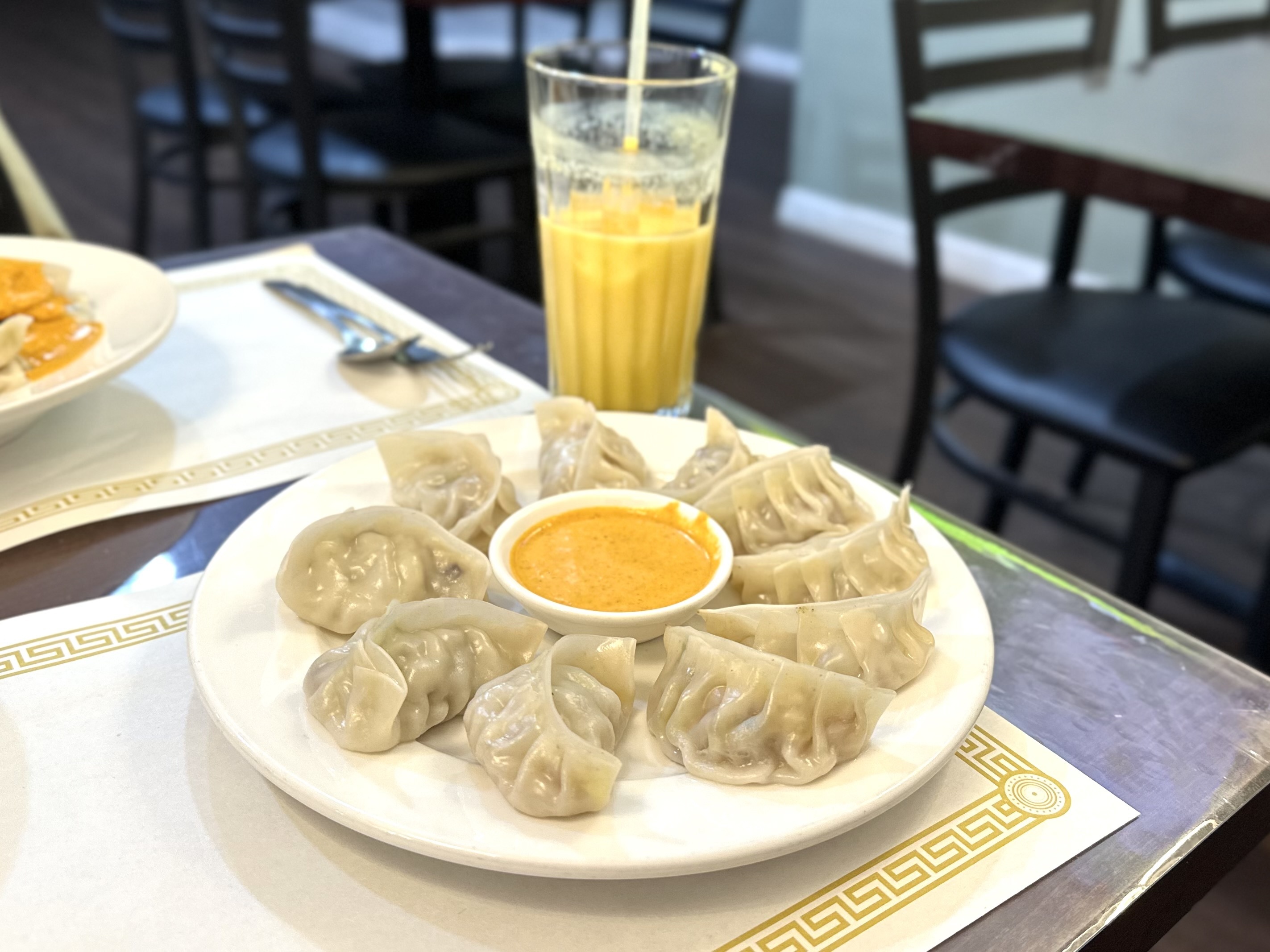
Carrick Bar & Grill
The converted bar in a mini-mall behind a strip mall (next to an excellent Himalayan grocery store) is a destination for big, bold flavors. C-momo are the shining stars in the no-frills dining room. It’s fried to a zone between crisp and tender, with a coating laced with cumin and paprika. The heat has a bit of a frontal assault, which then builds and lingers. The dish's green and red bell pepper chunks add a nice sweetness to balance it out. Chicken and pork steamed momo are packed with sapidity, as are the straightforward achar. Carrick Bar & Grill is one of the few Bhutanese-Nepali restaurants in the area with a liquor license.
2122 Brownsville Road, Carrick; tinyurl.com/carrickbargrill
Nepali Asian Restaurant
Nepali Asian Restaurant was part of the 2017-2018 introduction of Bhutanese-Nepali restaurants to the South Hills. The peppy-savory blend of tomatoes and peanuts in the kitchen’s achar is a solid accompaniment to the chicken, vegetable and pork-steamed momo.
2122 Brownsville Road, Carrick
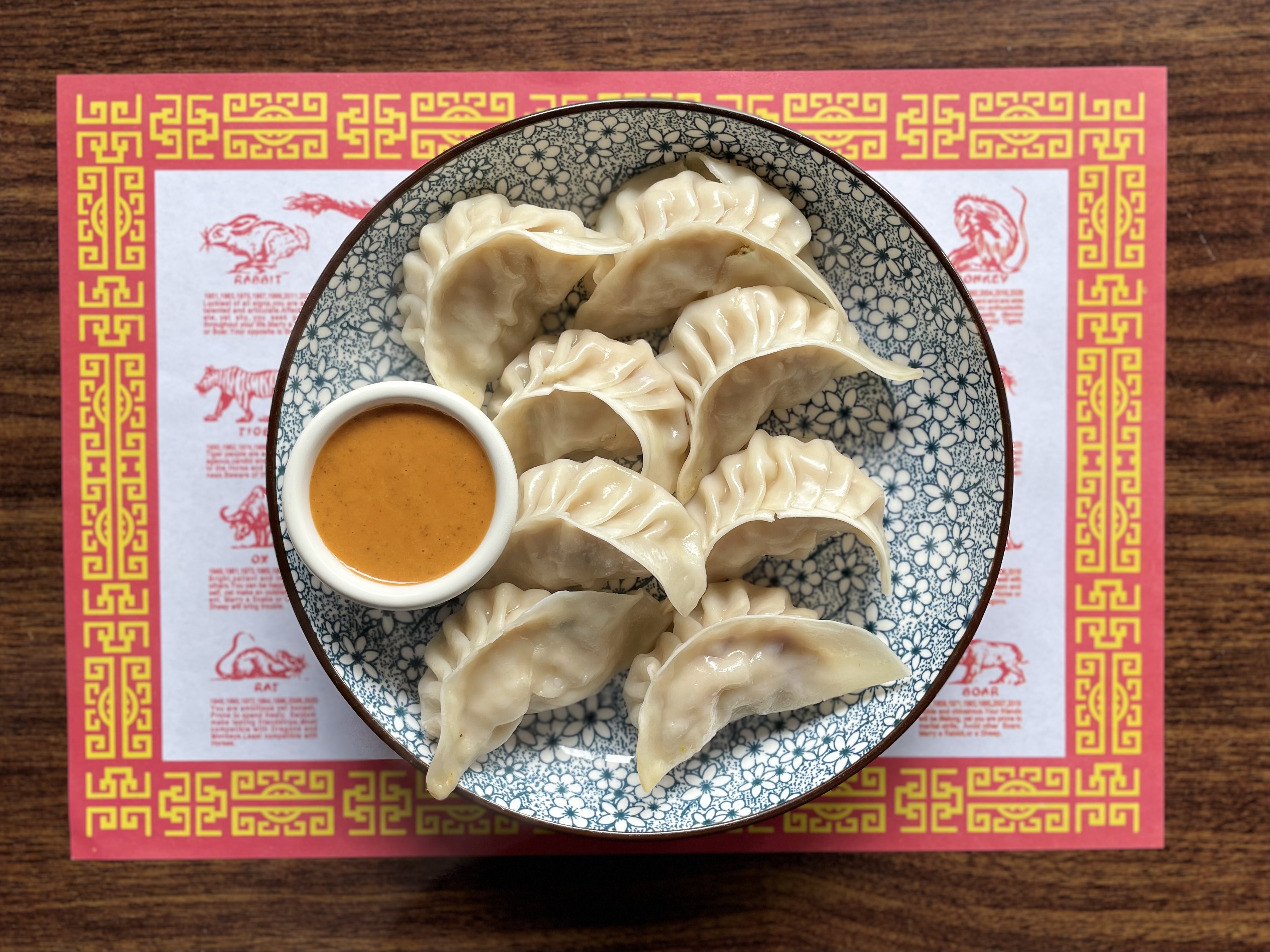
Subba Asian Restaurant
Deo Subba is one of Pittsburgh’s Bhutanese-Nepali trailblazers. He opened his eponymous restaurant on the second floor of a Deutschtown building in 2014, operating it as a hidden-in-plain-sight gem until he moved around the corner to East Ohio Street in late 2022. Juicy steamed chicken momo and its accompanying sneaky-hot momos chutney, resonant with tomato, red chile and garlic, is a must-get. Gorgeously crimped vegetable momo offer a more subtle option. Subba is the most accessible momo restaurant from Downtown.
422 E. Ohio St., Deutschtown; facebook.com/subbapittsburgh
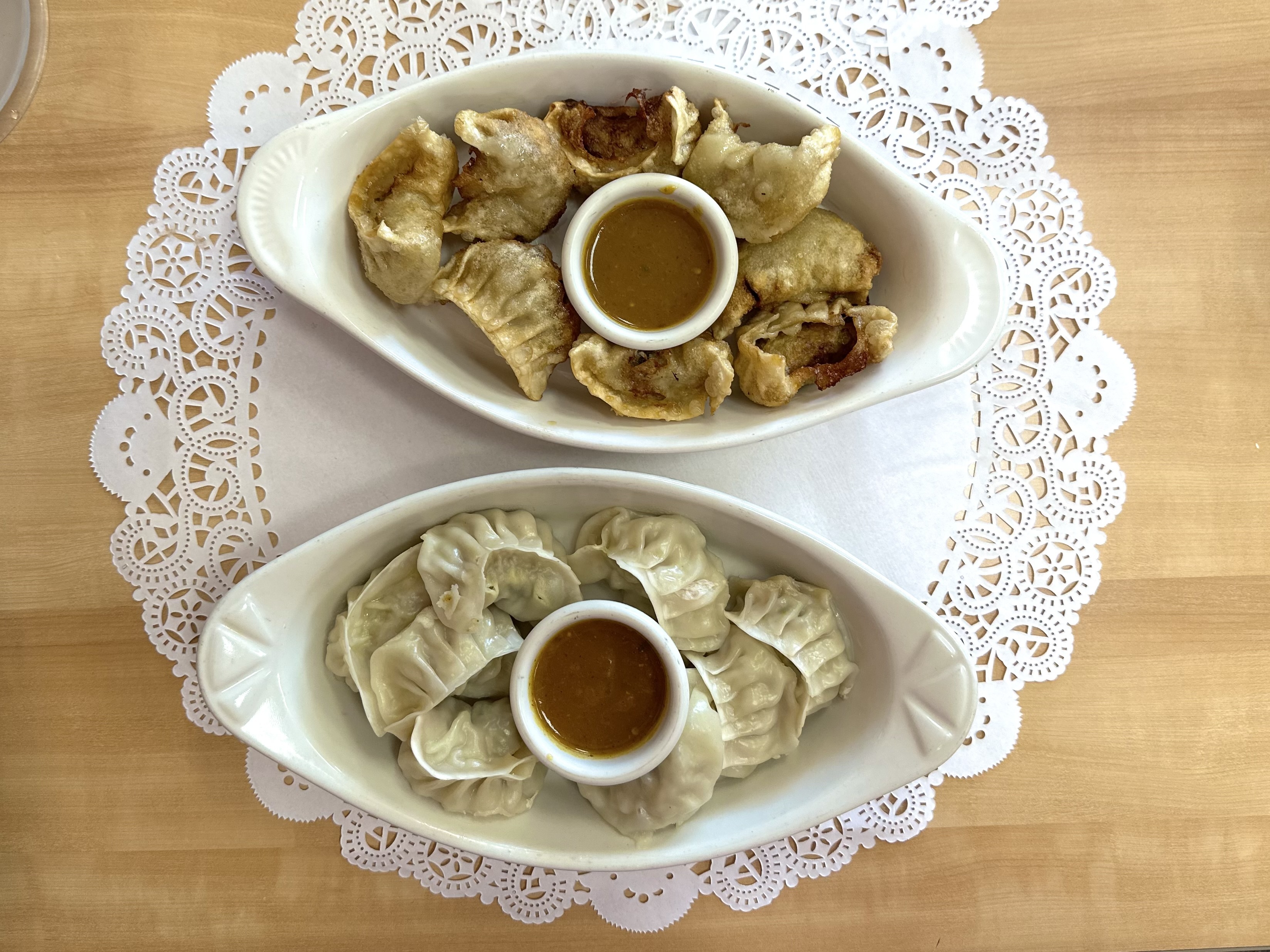
Indo-Asian Cuisine
Baking spices like cinnamon take center note in the achar at Indo-Asian Cuisine, driving a tangier, sweet sauce than you'll find at most other restaurants. It's also as much or more about the filling here. Hand-chopped chicken, for example, is a complex mix of spices and aromatics beautifully packed into a tender, steamed skin. Fully deep-fried momo aren't quite as common as the pan-fried versions, so be sure to grab an order of those, too. The oily bath gives the dumplings an extra-crunchy texture and juiciness.
1739 Rostraver Road, Belle Vernon; facebook.com/IndoAsianCuisine
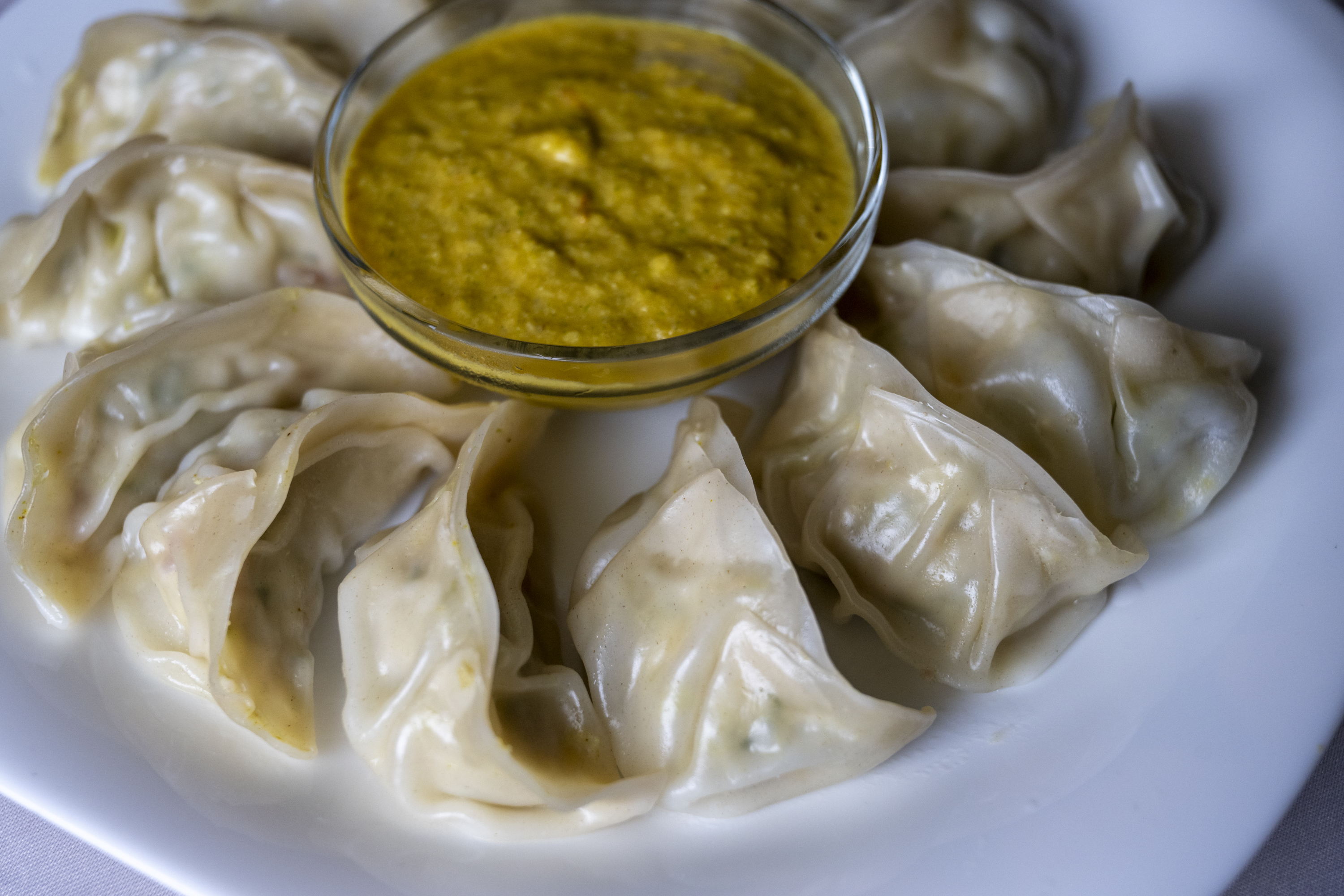
Radhika Acharya, who was born in Bhutan and raised in a refugee camp in Nepal, grew up eating and cooking the traditional foods of her parents and grandparents. The rich blend of history and flavors she experienced as a child continue to reflect her cultural identity as an adult in a new country.
Now a stay-at-home mother to three in the South Hills, she regularly prepares the flavorful Nepali chow mein, roti, potato curry and fried samosas of her youth for her own family. That they love it goes without saying.
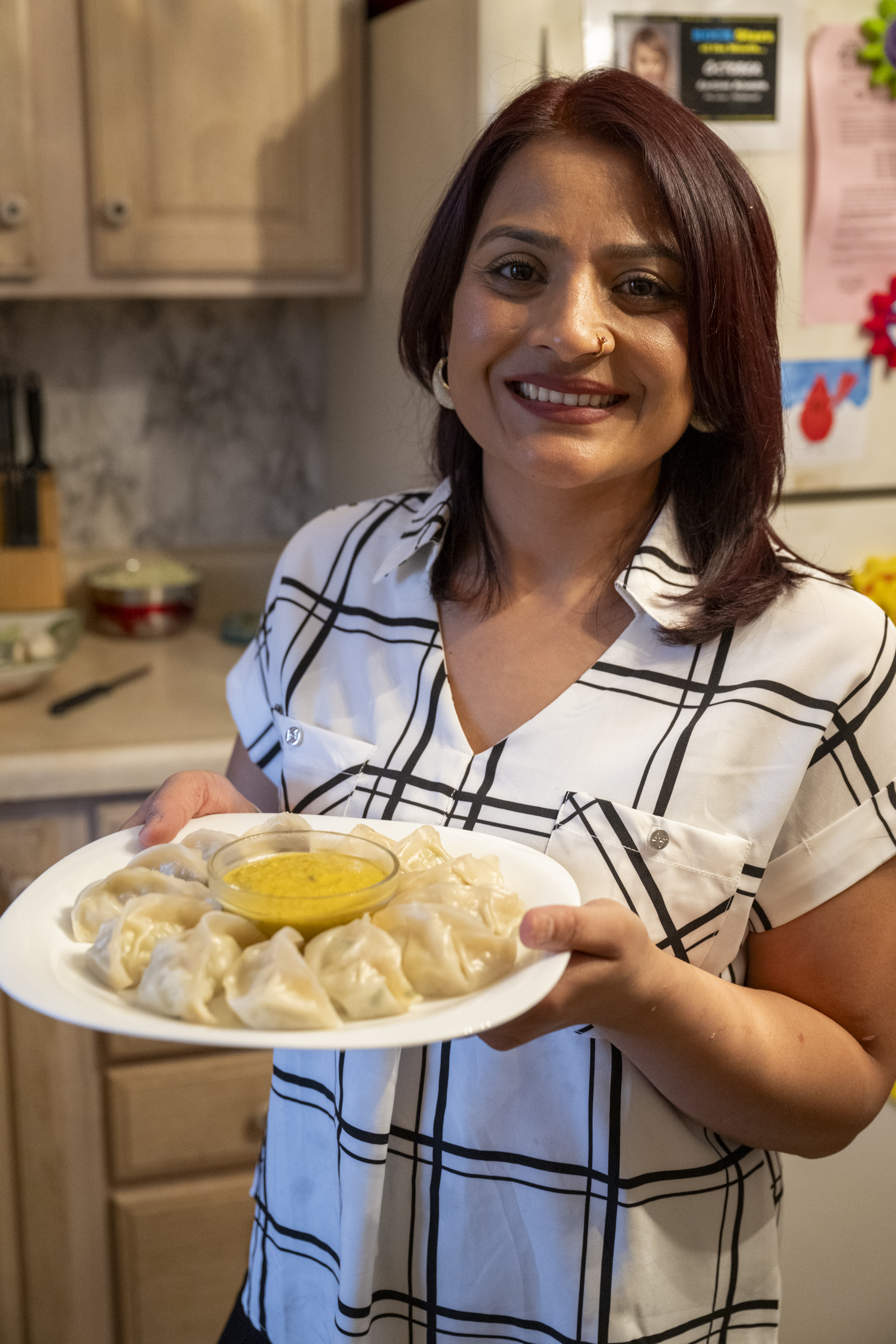
“In our culture, our parents teach us to cook,” Acharya says of the rice- and dal-based dishes she learned to make alongside her mother, Tila, and maternal grandmother, Madhu, using deceptively simple techniques and lots (and lots) of fresh vegetables before immigrating to Pittsburgh at age 20 in 2009.
“Cooking is my passion, and my kids enjoy it.”
They’re especially crazy about momo, a type of soft and pillowy steamed dumpling that’s served as a popular street food in cities such as Kathmandu. Home cooks also love serving it at birthday parties, holidays and other family celebrations.
Characterized by their distinctive, rose-like pleated shape, momo are thought to have come to Nepal via Tibet sometime in the 14th century. First filled with juicy yak meat (a lean protein similar in flavor to elk or bison), today they’re usually filled with minced chicken, pork or lamb (and sometimes cheese), vegetables and regional spices and herbs.
Unlike Chinese dumplings, which feature a thin and more delicate dough wrapper, momo offer a heartier bite with a thick, chewy dough. They’re typically steamed, but can also be fried.
The food of the landlocked country located high in the Himalayas of South Asia is strongly influenced by Chinese and Indian cuisines, which explains Acharya’s penchant for chow mein and potato-filled samosas. Then again, the fiery dipping sauce served with momo stands in stark contrast to the soy-based sauces you typically get with Chinese dumplings.
Momo chutney is built around tomatoes and warm spices such as cumin, coriander, garlic, mustard seed and ginger, with dried chilies adding a lip-tingling kick.
“The spices really make the difference,” says Acharya, whose family recipe also includes toasted sesame seeds along with a generous pinch of turmeric — “to make it yellow.”

Many Himalayan dishes — including a spicy signature Bhutanese stew made with hot chili peppers and cheese called ema datshi — hang their flavor hat on the slow burn of chilies. “And pretty much everything is handmade,” she adds.
Because Acharya makes momo so often for her family, and in such large quantities (a single recipe makes about 48 momo), she opts for commercial wrappers rather than making the dough from scratch, as her family did back in Nepal.
“Dough takes a long time! With wrappers, it’s easy,” she says with a laugh.
Per tradition, her 10-year-old son and 8-year-old daughter are often eager sous chefs, pinching the dough circles around the filling with a simple pierogi-like fold in mere seconds.
“They started when they were 5,” she says with obvious pride.
She typically uses ground chicken because she doesn’t eat pork, but any finely minced meat will do. The mix always includes lots of finely chopped green cabbage and occasionally some carrots. But really, any favorite fresh veggie can be used.
For a unique and authentic Nepali flavor, she always adds one or two tablespoons of momo masala, a spicy curry powder blend that includes cumin seed, black pepper, nutmeg, fenugreek and a host of other spices. (You can find it at Nepali groceries such as Nepal Supermarket and Nepali Bazaar on Saw Mill Run Boulevard in Brentwood and also on Amazon.)
Because the dumplings are steamed instead of fried, they retain all the nutrients of the filling, making momo a very healthful and filling dish, says Acharya. “There’s no chemicals and we only use fresh vegetables.”

She acknowledges there is a bit of a learning curve to folding a perfect momo just so. She’s content with three folds, though some cooks do up to five or six. But it soon will become easy if you remember to keep your thumb down and your forefinger up when you’re pinching the dough. And if you just can’t master it?
“It doesn’t matter,” she says. Even if you go with a simple, half-moon pinch to keep all the savory goodness together, “It tastes the same.”
She also offers these helpful tips: Texture is important! The filling should walk the line between dry and moist and be well seasoned, and it’s also important to grate or finely chop whatever vegetables you’re using so that the wrapper doesn’t break. This is especially true for hardier ingredients such as cabbage, garlic and ginger.
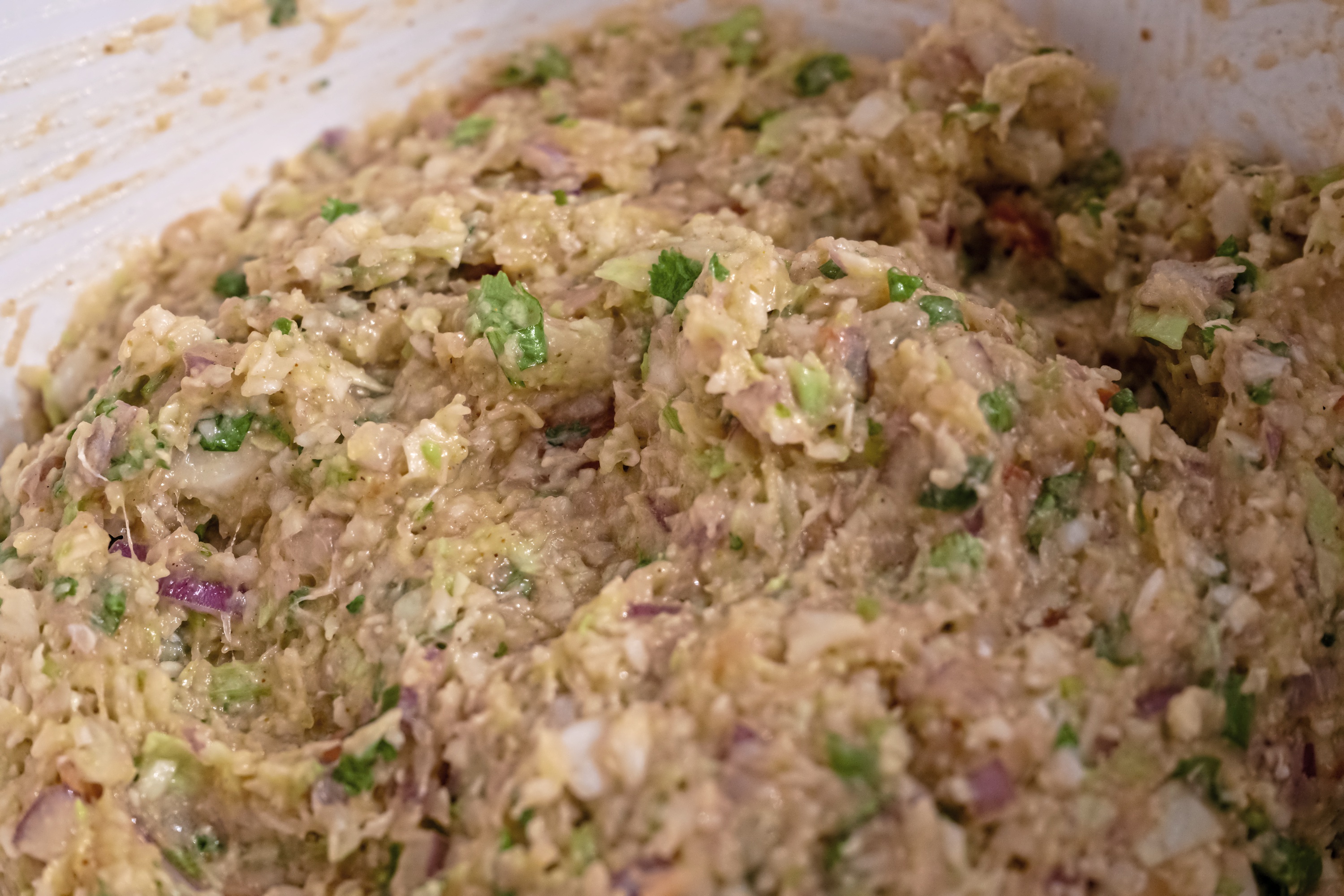
Above all (and this goes for all varieties of dumplings), resist the urge to make the momo as fat as possible, Acharya cautions, and keep them covered under a moist paper towel until you are ready to steam them. Overstuffing the wrappers will risk the dumpling falling apart while cooking and then, instead of a meal, you’ll just have a mess. One generous teaspoon of filling is plenty!
In addition, be sure to lightly coat the steamer tray with oil or nonstick cooking spray before adding the momo one at a time. Add them slightly apart from one another or else they will stick. They’re done when the dough is translucent and doesn’t feel sticky, usually around 10 minutes.
Because momo are typically made in big batches and taste best when freshly steamed, it’s OK to freeze whichever ones you don’t want immediately. Just be sure to first freeze them apart from one another on a tray before throwing them into a bag together. Otherwise, they might stick.
Recipe: Chicken Momo (dumplings)
PG tested
You can find momo masala, an aromatic mix of Nepali spices, at Nepali grocery stores like Nepali Bazaar in Brentwood, as well as in any Indian market. It is also available on Amazon. Gyoza wrappers can be found in any Asian market and most larger grocery stores in the refrigerated section.
Following in the steps of her mother, Radhika Acharya eyeballs all of her ingredients, so measurements are not exact. You also can add more or less of any ingredient to taste, or substitute other favorite vegetables such as carrots.
For filling
1 pound ground chicken or turkey
½ whole green cabbage, finely chopped (about 5 cups)
½ large red onion, finely chopped (about ½ cup)
½ cup finely chopped fresh cilantro
3 green onions, chopped (about ¼ cup)
2 garlic cloves, very finely chopped and mashed
1-inch knob fresh peeled ginger, finely chopped and mashed
1 tomato, very finely chopped
1 or 2 heaping tablespoons momo masala (curry powder blend), or to taste
About 48 round dumpling or gyoza wrappers (about 3¼ inches wide)
For chutney
2 tablespoons canola oil
Sprinkle of coriander seeds
2 tomatoes, cut into wedges
¼ red onion, sliced
3 dried red chilies, divided
1 teaspoon turmeric
Handful of cilantro
1 clove garlic
½ cup sesame seeds
2 teaspoons lemon juice, or more to taste
Salt, to taste
1-inch knob of peeled ginger
Prepare filling. In a large bowl, combine the ground chicken or turkey, cabbage, onion, cilantro, green onion, smashed garlic and ginger, tomato and momo masala seasoning. Using your hands, mix lightly but thoroughly.
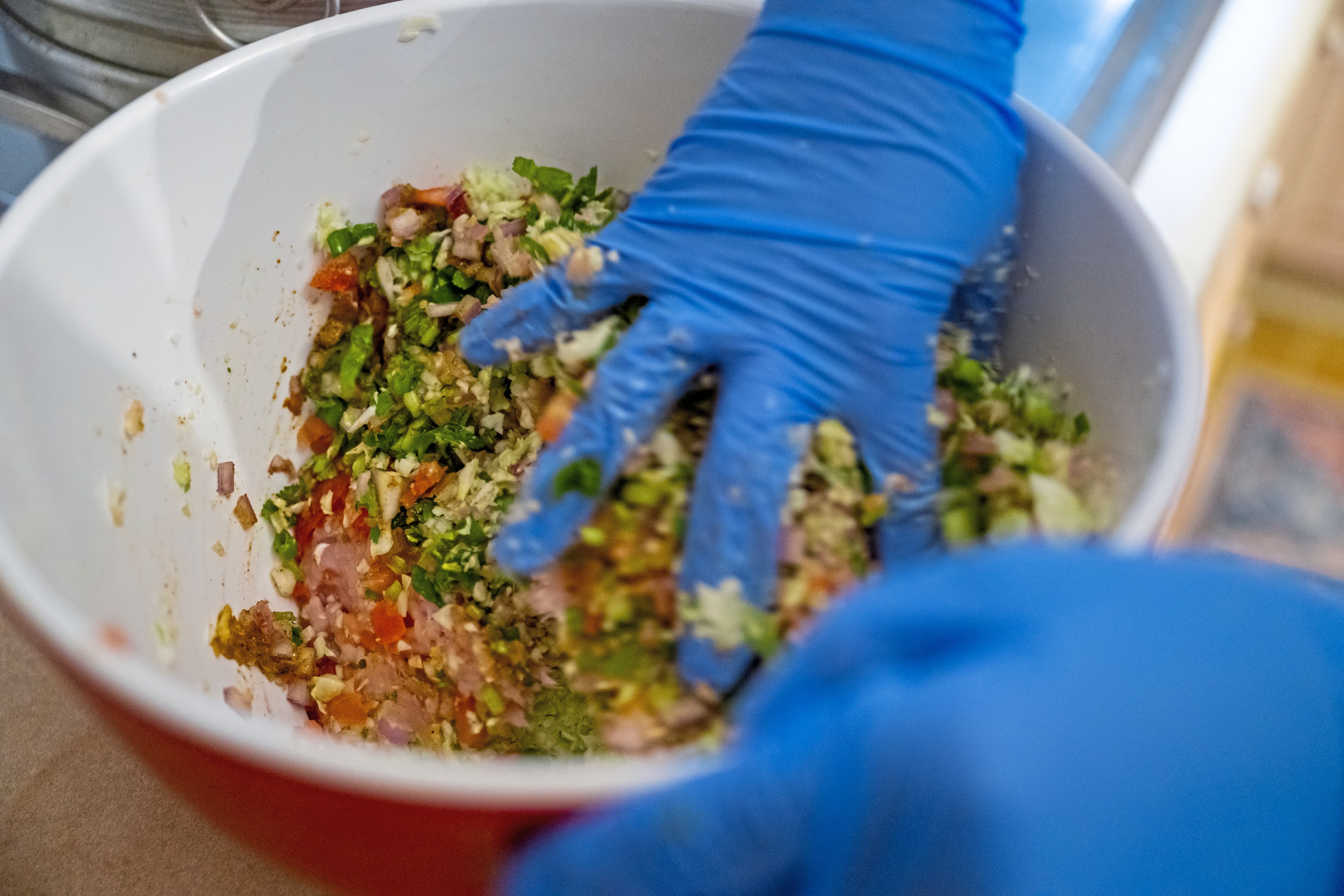
Fill wrappers. Spoon about 2 teaspoons of filling onto the upper half of each wrapper. With a wet fingertip, moisten the edge of each wrapper and fold up and over the filling into a half-moon. Pleat the edges by making small folds in the dough, pressing them flat as you work your way along the edge. (Radhika makes three folds, but you can do as many as five or six.)
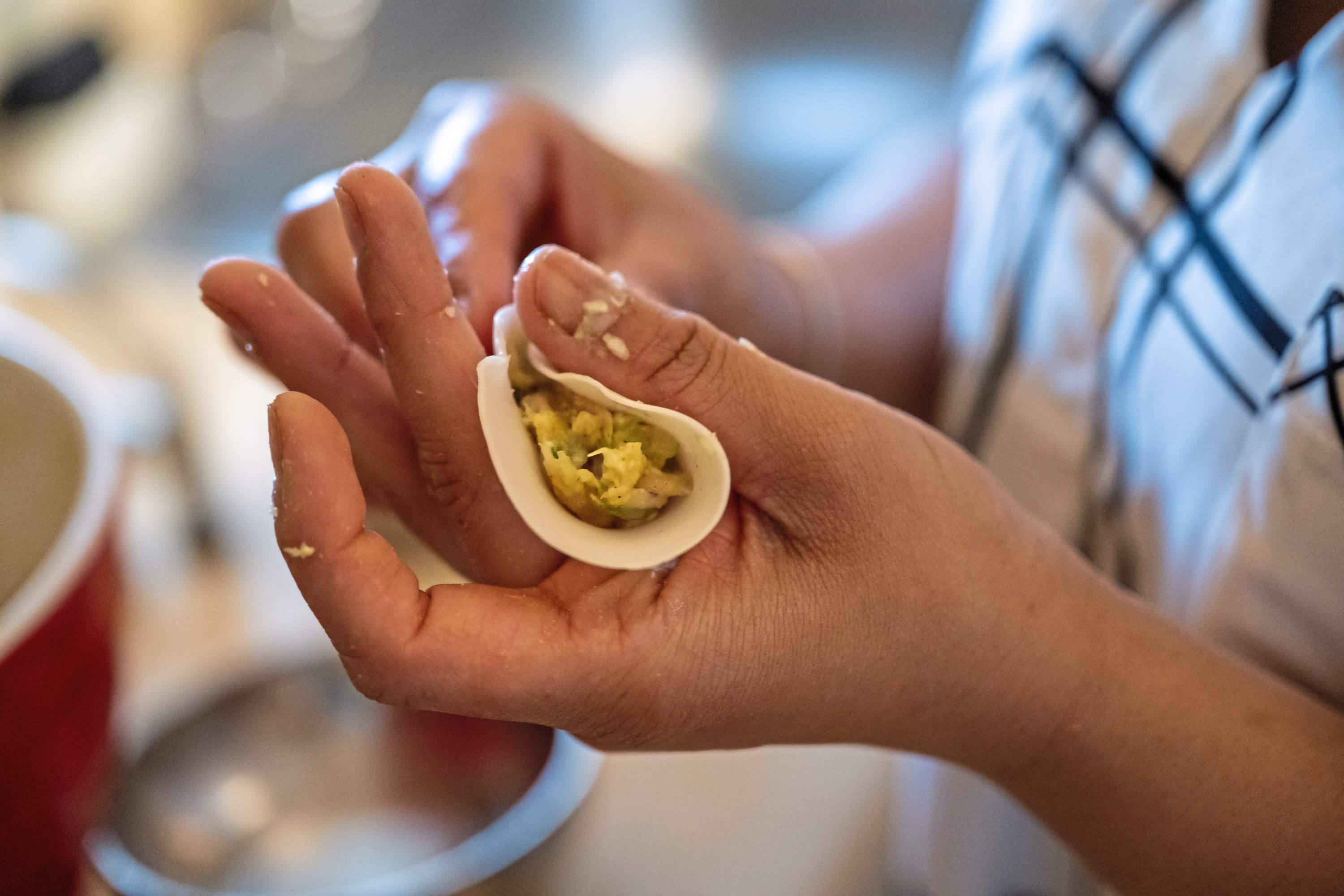

Place finished dumplings on a nonstick surface and, if not cooking right away, cover lightly with damp paper towels and refrigerate. You also can freeze them for up to 3 months.
When ready to cook, boil water in the bottom of a large steamer. Lightly coat the steamer tray with oil or nonstick spray. Gently add the dumplings, one at a time, making sure they do not touch. (They will expand slightly while cooking.)

Steam in batches for 10 to 15 minutes, or until the wrappers are slightly translucent and feel firm.
While dumplings are steaming, prepare momo chutney.
Heat oil in a small frying pan over medium-high heat. Sprinkle in a few coriander seeds and cook until they sizzle and pop, around 20 seconds. Add tomatoes, red onion, 2 red chilies, turmeric and a pinch of salt. Stir to combine, then cover and allow the vegetables to cook until they are soft, about 5 minutes.


Add cilantro and garlic clove, and stir to combine. Cook, smoothing with a wooden spoon every so often, until the cilantro is wilted and garlic softens, then cover again with lid and allow to cook another 5 minutes. Remove from frying pan to a plate and allow to cool.
In a dry skillet or frying pan over medium heat, heat raw sesame seeds until golden brown and fragrant, stirring occasionally with a wooden spoon, about 3-5 minutes.

Place toasted sesame seeds in a blender with the cooked vegetables, add lemon juice and a pinch of salt and give it a good whirl. Add a little water to thin the sauce and blend again. Add remaining dried chili and 1-inch knob of peeled ginger, and blend until completely smooth. You can add a little more water if it’s still too thick.

Arrange steamed dumplings on a plate and serve with chutney.
Makes about 48 dumplings.
— Radhika Acharya, Pleasant Hills
Gretchen McKay: gmckay@post-gazette.com.
Hal B. Klein
Gretchen McKay
Hal B. Klein
Lucy Schaly
Benjamin B. Braun
Justin Guido
Tim Robbibaro
James Hilston
Laura Malt Schneiderman
Advertisement
Advertisement